Celia A. Harvey, Jonah Busch and Muhammad Farid, Jakarta | Thu, 11/11/2010 10:05 AM | Opinion
A | A | A |
The international community is currently tackling two urgent global problems: the rapid increase in climate change and the ongoing loss of biodiversity. Two weeks ago, delegates from around the world gathered in Nagoya, Japan to discuss the failure of countries to meet their 2010 biodiversity targets and to propose new targets for reducing further biodiversity loss. And, at the end of this month, country delegates will convene in Cancun, Mexico, to continue the ongoing climate negotiations and seek solutions to the climate crisis.
One topic that is critical is how to deal with deforestation and degradation of the world’s tropical forests.
Each year, roughly 13 million hectares of forests are cleared globally, resulting in the emission of around 4.4 billion tons of CO2, or roughly 15 percent of the greenhouse gas emissions responsible for climate change.
This deforestation also leads to the loss of hundreds — or perhaps even thousands — of plant and animal species, and negatively impacts local and indigenous communities who depend on these forests for their livelihoods.
In Indonesia alone, it is estimated that roughly 1 million hectares of forests are lost each year, resulting in the annual emission of more than a billion tons of CO2, and negatively impacting Indonesia’s biodiversity. Indonesia has a very rich biodiversity, including at least 58 amphibian species, 182 bird species and 141 mammal species that are endemic to its forests and are found nowhere else on earth.
REDD+ offers an opportunity to tackle both of these problems simultaneously. REDD+ is an international policy mechanism in which developed countries provide incentives to developing countries to reduce emissions from deforestation and degradation, and to enhance carbon sequestration through forest conservation, carbon stock enhancement and sustainable management.
For Indonesia, REDD+ is an unprecedented opportunity to conserve its remaining forests, significantly reduce its greenhouse gas emissions and earn revenue in support of sustainable development. It is also a unique opportunity to conserve forest habitat for the country’s remarkable biodiversity.
Although the REDD+ (Reducing Emissions from Deforestation and Degradation) mechanism is designed primarily to reduce greenhouse gas emissions from the forest sector, there are several reasons why it is also likely to provide unprecedented benefits for biodiversity.
First, for REDD+ to be successful, policy-makers will need to find ways to address the many drivers of deforestation and degradation of tropical forests. Most of these drivers of deforestation are also the key threats to biodiversity conservation.
Second, the approaches that policy makers will use to conserve and sustainably manage forests will likely build on approaches already developed and implemented by the conservation community. These key approaches include payments to local communities and jurisdictions that conserve forest, the expansion of the protected area system, the improved management of existing protected areas, recognition of indigenous communities and community-managed areas, prevention of fires, as well as the use of agroforestry systems and agricultural intensification on degraded land to reduce pressure on remaining forests.
Third, both REDD+ and biodiversity conservation are dependent on good governance. Under REDD+, governments will need to strengthen their forest governance, enhance their capacity to monitor forest cover and illegal logging, and develop clear legal and financial frameworks and law enforcement to protect remaining forests.
In addition, they will need to clarify land tenure issues and carbon rights. All of the steps towards improving forest governance will not only help ensure that REDD+ conserves forests and reduces greenhouse gas emissions, but also benefit the biodiversity that relies upon these forests.
Finally, the success of both REDD+ and biodiversity conservation efforts will depend on active participation and support of local stakeholders. If local communities and stakeholders are well-informed and supportive of efforts to reduce deforestation and degradation and actively involved in decision-making and implementation of REDD+, it is more likely that forests will be conserved over the long term, providing both mitigation and biodiversity benefits.
Of course, REDD+ on its own is not enough to solve either the climate change or biodiversity crisis. In order to tackle climate change, additional mitigation activities such as reducing fossil fuel use, using renewable energy and promoting energy efficiency through development of a low carbon development strategy are needed.
To achieve biodiversity conservation, additional conservation measures will be needed in non-forest ecosystems and in areas that may have little mitigation potential but are of important conservation value.
However, if REDD+ is well-designed and appropriately implemented, it would be a giant and historic step forward towards solving both the climate and biodiversity crises. With its vast (but rapidly disappearing) forests and extraordinary biodiversity, Indonesia is a unique position to provide global leadership in ensuring REDD+ delivers both climate mitigation and biodiversity benefits.
Dr. Celia Harvey is vice president of Global Change and Ecosystem
Services at Conservation International. Dr. Jonah Busch is a climate and forest economist at Conservation International. Muhammad Farid, MSc. is a climate change
specialist for Conservation International Indonesia Program.
Subscribe to:
Post Comments (Atom)

No comments:
Post a Comment